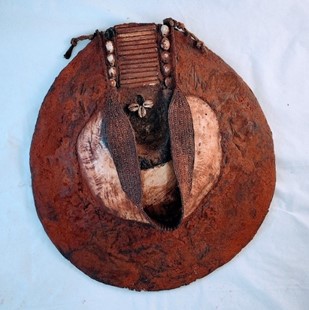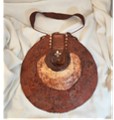The Kina Shell Moka Breastplate is a type of body decoration that is worn primarily by men of the different highlands regions of Papua New Guinea. The breastplate may be worn on the neck, the chest, or in some regions, on the back. The breastplate consists of a kina shell — a large piece of pearl oyster shell — that is set into a backing composed of different substances such as cloth or netting, plant fibers, feathers, and/or mud, which is then coated with a plant resin that dries to a hard, glassy finish. Wooden rods and cowrie shells may also be added, along with a woven plant fiber strap, and the entire object is covered in red ochre mineral pigment.
The distinct red ochre color of the Moka breastplate is symbolic of blood, including menstrual blood. While women in some societies wear this adornment, the Moka breastplate is much more often worn by men as a symbol of male power and superiority over women. Men rub red ochre over the breastplate and strap, and over their bodies, to symbolize their presumption of control over women.
The Moka breastplate is also a symbol of wealth and status in Papua New Guinea highlands societies. The size of the kina shell, the breastplate backing, and the adornments indicate the level of status and power of the current or previous owner.

Kina Shell Moka Breastplate
Highlands cultures, Papua New Guinea
20th century
Red ochre pigment, mud, plant fiber netting and strap, plant resin, cowrie shells, and wooden rods
L. 37.7 cm x W. 1.5 cm x H. 42 cm
MSU collection #2018.1.19

Kina Shell Moka Breastplate
Highlands cultures, Papua New Guinea
20th century
Red ochre pigment, mud, plant fiber netting and strap, plant resin, cowrie shells, and wooden rods
L. 37.7 cm x W. 1.5 cm x H. 42 cm
MSU collection #2018.1.19
For more information, you may contact the researcher(s) noted in the title of this exhibit entry, or Dr. Billie Follensbee, the professor of the course, at BillieFollensbee@MissouriState.edu
